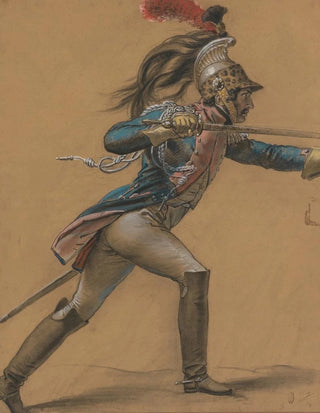Art print | French dragon study for The Revolt of Cairo - Anne-Louis Girodet-Trioson


View from behind

Frame (optional)
Art print Study of French dragons for The Revolt of Cairo - Anne-Louis Girodet-Trioson – Captivating Introduction
In the fascinating universe of art, some works transcend the mere framework of aesthetics to become witnesses of an era, reflections of a thought. "Study of French dragons for The Revolt of Cairo" by Anne-Louis Girodet-Trioson fits into this tradition. This piece, both technical and imaginative, evokes a turbulent period in history, when France distinguished itself on the global stage, notably through its colonial expeditions. Girodet, with his mastery of drawing and keen sense of composition, immerses us in a world where the fantastic and the real intertwine, revealing the tensions and aspirations of a bygone time.
Style and uniqueness of the work
Girodet's work stands out for its innovative approach and unique style. In "Study of French dragons for The Revolt of Cairo," the artist does not hesitate to deviate from academic conventions to explore bolder themes. The dragons, symbols of power and mystery, are depicted with striking grandeur. Far from being a simple representation, Girodet injects a lively dynamism into each of his creations. The flowing lines and vibrant colors create an almost dreamlike atmosphere, where every detail seems to summon a story to tell. This blend of realism and fantasy, this dialogue between the imaginary and the historical, makes this work a true masterpiece that continues to inspire and amaze.
The artist and his influence
Anne-Louis Girodet-Trioson, an emblematic figure of Neoclassicism, marked his era with his undeniable talent and originality. A pupil of Jacques-Louis David, he knew how to break free from established norms to forge a style that is uniquely his own. His work reflects a time seeking identity, where art becomes a means of expressing human passions and social conflicts. Girodet, through his bold iconographic choices and refined technique, managed to capture the collective imagination of his time. His influence extends well beyond his artistic production, touching the

Matte finish

View from behind

Frame (optional)
Art print Study of French dragons for The Revolt of Cairo - Anne-Louis Girodet-Trioson – Captivating Introduction
In the fascinating universe of art, some works transcend the mere framework of aesthetics to become witnesses of an era, reflections of a thought. "Study of French dragons for The Revolt of Cairo" by Anne-Louis Girodet-Trioson fits into this tradition. This piece, both technical and imaginative, evokes a turbulent period in history, when France distinguished itself on the global stage, notably through its colonial expeditions. Girodet, with his mastery of drawing and keen sense of composition, immerses us in a world where the fantastic and the real intertwine, revealing the tensions and aspirations of a bygone time.
Style and uniqueness of the work
Girodet's work stands out for its innovative approach and unique style. In "Study of French dragons for The Revolt of Cairo," the artist does not hesitate to deviate from academic conventions to explore bolder themes. The dragons, symbols of power and mystery, are depicted with striking grandeur. Far from being a simple representation, Girodet injects a lively dynamism into each of his creations. The flowing lines and vibrant colors create an almost dreamlike atmosphere, where every detail seems to summon a story to tell. This blend of realism and fantasy, this dialogue between the imaginary and the historical, makes this work a true masterpiece that continues to inspire and amaze.
The artist and his influence
Anne-Louis Girodet-Trioson, an emblematic figure of Neoclassicism, marked his era with his undeniable talent and originality. A pupil of Jacques-Louis David, he knew how to break free from established norms to forge a style that is uniquely his own. His work reflects a time seeking identity, where art becomes a means of expressing human passions and social conflicts. Girodet, through his bold iconographic choices and refined technique, managed to capture the collective imagination of his time. His influence extends well beyond his artistic production, touching the






